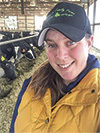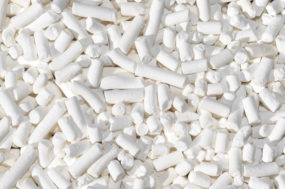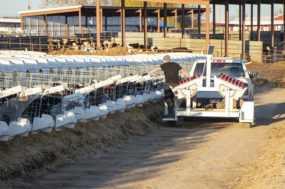Tell your story. Get on social media. Join the bandwagon that is now everyday life for the consumer. Odds are you have come across an article or person that has encouraged you to either tell your personal story or your farm story. If you know me – and odds are you don’t – you know I am on social media. I post pictures of our farm and write up small blogs on Facebook and Instagram.
We are an average-sized farm in Wisconsin, and times are pretty darn tough. All of the above got me thinking. How do we get through to the consumer? How do we change the tide and get people consuming milk again? How do we start making a profit again? As a family farm, we have talked for years about making our own cheese or bottling our own milk. But now is not the time to start such a grand venture.
So what is one to do in these troubling times? I decided to do something about it and started selling a product that we already have that is made from our own milk. Our milk is made into cheese. I buy the cheese at wholesale and sell it at markets, and I’m beginning to start a business of selling cheese in gift boxes. I know what you’re thinking, and yes, I know this has all been done before. I’m not saving the farm, but I have certainly learned a few things.
It all started when I saw a man named Damian Mason speak. I then followed his Facebook page where he makes videos, and talks politics and some economics. You may have heard some of his catch phrases like, “Agriculture: Because starvation sucks.” But one video stuck out to me. He spoke about one of his favorite events in the world – the Indy 500. He raved about how they have not just made it a race, but an experience. The concerts, drinks and after-party make it a fun experience for everyone, even if you don't like car racing.
I wanted to start making an experience for the consumer. I wanted to start making a product that brought them to the farm and felt welcome. This had plagued me for months while I thought outside the box and tried to create a product worth buying and – gasp – maybe even profiting from. The fact is it’s already there. It’s already in front of the consumer; we just have to bring it to life. I have had orders from New York to South Dakota from people who want to taste our cheese, because they know us and the story behind it. They see my posts and know my passion behind my photos. They want to try it and eat the end result of all our hard work. We just have to put a face and story behind that wedge of cheese.
Another observation I have made since starting this venture is people love to talk about where they get their food. If they buy product from a farmer, they are going to tell people about it. Consumers don't tell stories often about getting cheese from the grocery store. They would rather talk about getting them from markets and events, even farms. This gets people talking! This creates positive stories and images that people want to talk about. Any positive is good in my mind at this point, honestly.
At markets and events I sell at, many people ask me, “Where else can I get this cheese?” I proceed to tell them the stores where it’s sold, and they respond that they have never noticed it before. Next they say that they will for sure be buying it the next time they go. Why? Because they met the farmer face-to-face. What if we could do the same thing on social media? What if we were open and told people about our milk products? Do you think they would be more inclined to buy it? I think so.
One of my last observations is the love-hate relationship with our processors. There has been a gap that we just can’t seem to close. I think it’s time we helped them and the retailers out and tell our own story about our products. Who knows how to tell it better? Telling our story is free on social media. We need to stand by our products and by our processors to show the public that we have a product worth eating. Retailers lack credibility. I’ve read some research from The Center for Food Integrity that the public still believes in the farmer. Here, my friends, is the missing link. We need to help our processors tell our story. We need to help market our own product.
We need to create that experience from pasture to plate for the consumer because it doesn't sound the same coming from the processor or retailer. Friends, it’s time to add another career to our resume. I have heard a lot of feedback from customers and answered their questions. You don't need to go as far as I do and actually sell product, but we need to be there to answer those questions and create that connection. You just need to show the consumer how you produce it and support whatever product your milk creates. That doesn't sound too complicated, right?
Bottom line, we need to start selling an experience and get people talking. Odds are consumers are going to respond more to us than any marketing or sales pitch presented by a processor or retailer. I’ve seen it. We need to connect the dots and give the consumer the experience from pasture to plate. Because this marketing is free. This marketing and advertising helps out the processor that in turn should help us in the long run. It’s time to fix that missing link between consumer and farmer. When the consumer sees the product you make, the actual end result will be them going out of their way to find it because they now know where it comes from.
I may not be saving the farm (maybe someday), but I know I am doing my part by making a deeper impact and creating the total milk experience for the consumer. ![]()

-
Amber McComish
- Dairy Producer
- Darlington, Wisconsin
- Email Amber McComish





